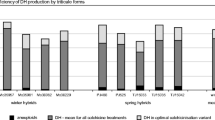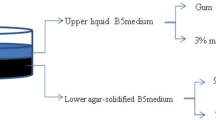Abstract
In cereals, chromosome doubling of microspore-derived haploid plants is a critical step in producing doubled haploid plants. This investigation was undertaken to study the effect of incorporation of colchicine in the induction medium for anther culture, and the effect of colchicine on anther culture-derived plants of triticale grown under controlled greenhouse conditions. In the latter case, chromosome doubling of adult sterile plants derived from anther culture of fourteen triticale populations was attempted, where androgenetic plants with non-dehiscent anthers were cloned and subjected to the colchicine treatment, and then grown with the aid of hydroponics. The hydroponic system provided optimal conditions for recovery of the affected haploids from the toxic effects of colchicine treatment and all colchicine-treated plants survived. A topcross-F1 (TC1F1) population with timopheevii cytoplasm produced the highest percentage of plants with seed-set either due to chromosome doubling by colchicine (98%) or spontaneous doubling of chromosome number (15%). Colchicine-treated anthers performed inferior than control in both induction and regeneration phases. One of the key observation of this study was the reversal from reproductive stage back to the vegetative stage which in turn enabled further cloning of haploid plants under hydroponic conditions once they were identified as sterile. The one hundred percent survival rate of in vitro-derived plants, 100% survival rate of colchicine treated haploid plants and the high chromosome doubling success rate (X = 82.3) observed in this study imply that a temperature-controlled greenhouse with an hydroponic system provides an efficient environment for inducing chromosome doubling of haploid plants in cereals.
Similar content being viewed by others
References
Amssa, M., J. De Buyser & Y. Henry, 1980. Origin of the diploid plants obtained by in vitro anther culture of bread wheat (Triticum aestivum L.): effect of cold pretreatment and of in vitro culture on doubling. C R Acad Sci, Paris 290: 1095–1097.
Arzani, A. & N.L. Darvey, 1998. Assessment of doubled haploids and mid-generation population of forage and dual purpose triticale for rust resistance under Australian conditions. In: P. Juskiw (Ed.), Proc 4th Int Triticale Symp, 26–31 July, 1998, pp. 164–172. Red Deer, Alberta, Canada.
Barnabas, B.,P.L. Pfahler & G. Kovacs, 1991. Direct effect of colchicine on the microspore embryogenesis to produce dihaploid plants in wheat (Triticum aestivum L.). Theor Appl Genet 81: 675–678.
Barnabas, B., B. Obert & G. Kovacs,1999. Colchicine, an efficient genome-doubling agent for maize (Zea mays L.) microspores cultured in anther. Theor Appl Genet 18: 858–862.
Charmet, G.C., S. Bernard & M. Bernard, 1986. Origin of aneuploid plants obtainedby anther culture in triticale. Can J Genet Cytol 28: 444–452.
Hansen, N.J.P. & S.B. Andersen, 1998.In vitro chromosome doubling with colchicine during microspore culture in wheat (Triticum aestivum L.). Euphytica 102: 101–108.
Hassawi, D.S. & G.H. Liang, 1991. Antimitotic agents: effects on double haploid production inwheat. Crop Sci 31: 723–726.
Henry, Y., 1999. Origin of microspore-derived dihaploid and polyhaploid invitro plants. Plant Tiss Cult & Biotech 4: 127–135.
Henry, Y. & J. De Buyser, 1980. Androgenesis inwheat in the course of selection, 2. Seed production. Z Pflanzenzüchtg 84: 9–17.
Henry, Y. & J. De Buyser,1990. Wheat anther culture: agronomic performance of doubled haploid lines and the release of a new variety 'Florin'. Biotechnology in Agriculture and Forestry, Vol. 13 Wheat, pp. 285–352. Springer-Verlag, Berlin Heidelberg.
Kohlenbach, H.W. & W. Wernicke, 1978. Investigations on the inhibitory of agar and the function of active carbon inanther culture. Z Pflanzenzüchtg 86: 463–472.
Luckett, D.J. & N.L. Darvey, 1992. Utilization ofmicrospore culture in wheat and barley improvement. Aust J Bot 40: 807–828.
Luckett, D.J.,S. Venkatanagappa, N.L. Darvey & R.A. Smithard, 1991. Anther culture of Australian wheat germplasm using modified C17 medium and membrane rafts. Aust J Plant Physiol 18: 357–367.
McCullagh, P. & J.A. Nelder,1987. Generalized Linear Models. Second edition, Chapman and Hall, London.
Metz, S.G., H.C. Sharma, T.A. Armstrong & P.N. Mascia, 1988. Chromosome doubling and aneuploidy in anther-derived plants from two winter wheat lines. Genome 30: 177–181.
Ouyang, J.W., H. Liang, S.E. Jia, C. Zhang, T.H. Zho, L.Z. He & X. Jia, 1994. Studies on the chromosome doubling of wheat pollen plants. Plant Sci 98: 209–214.
Ragot, M. & P. Steen, 1992. Genetic and environmental effects on chromosome doubling of sugerbeet (Beta vulgarisL.) haploids. Euphytica 63: 233–237.
Raquin, C., M. Amassa, Y. Henry, J. De Buyser & S. Essad,1982. Origin of polyploid plants obtained through in vitro anther culture. Cytophotometrical analysis of Petunia and wheat microspores in situ and in vitro. Z. Pflanzenzüchtg 89: 265–277.
Redha, A., T. Attia, B. Buter, S. Saisingtong, P. Stamp & J.E. Schmid, 1998. Improved production of doubled haploids by colchicine application to wheat (Triticum aestivum) anther culture. Plant Cell Rep 17: 974–979.
Rothamsted Experimental Station, 1990. Genestat 5,Release 2.2, Reference manual. Lewes Agricultural Trust, UK.
Saisingtong, S., J.E. Schmid, P. Stamp & B. Buter,1996. Colchicine-mediated chromosome doubling during anther culture of maize (Zea mays L.). Theor Appl Genet 92: 1017–1023.
Taira, T., Z.Z. Shao, H. Hamawaki & E.N. Larter, 1991. The effect of colchicine as adoubling agent for wheat-rye hybrids as influenced by pH, method of application and post-treatment environment. Plant Breeding 106: 329–333.
Thiebaut, J., K.J. Kasha & A. Tsai, 1979. Influence of plant development stage, temperatureand plant hormones on chromosome doubling of barley using colchicine. Can J Bot 57: 480–483.
Wan, Y.,J.F. Petolino & J.M. Widholm, 1989. Efficient production of doubled haploid plants through colchicine treatment of antherderived maize callus. Theor Appl Genet 77: 889–892.
Wan, Y., D.R. Duncan, A.L. Rayburn, J.F. Petolino & J.M. Widholm, 1991. The use of antimicrotubule herbicides for the production of doubled haploid plants from anther-derived maize callus. Theor Appl Genet 81: 205–211.
XuHan, X., H.C. Jing, X.F. Cheng, A. Iwanowska, H. Kieft, J.H.W. Bergervoet, S.P.C. Groot, R.J. Bino & A.A.M. van Lammeren, 1999. Polyploidization in embryogenic microspore cultures of Brassica napus L. cv. Topas enables the generation of doubled haploid clones by somatic embryogenesis. Protoplasma 208: 240–247.
Zhou, H. & C.F. Konzak, 1989.Improvement of anther culture methods for haploid production in wheat. Crop Sci 29: 817–821.
Author information
Authors and Affiliations
Corresponding author
Rights and permissions
About this article
Cite this article
Arzani, A., Darvey, N.L. The effect of colchicine on triticale anther-derived plants: Microspore pre-treatment and haploid-plant treatment using a hydroponic recovery system. Euphytica 122, 235–241 (2001). https://doi.org/10.1023/A:1012966506030
Issue Date:
DOI: https://doi.org/10.1023/A:1012966506030




